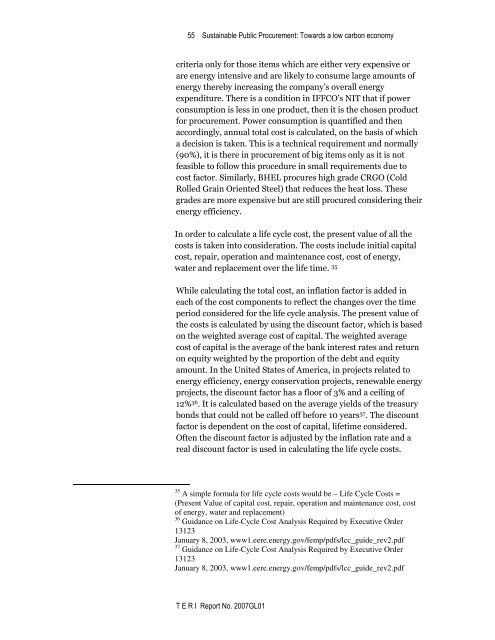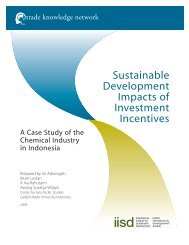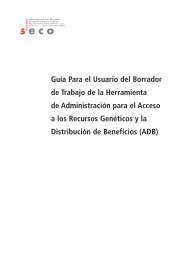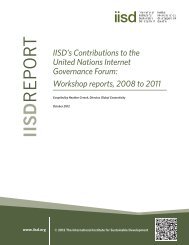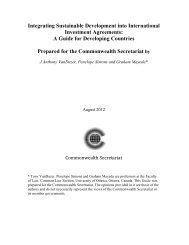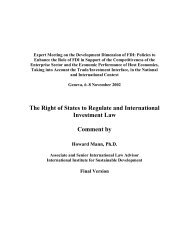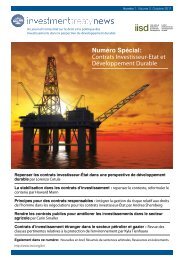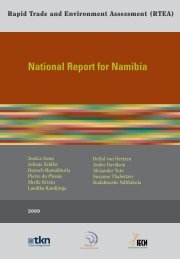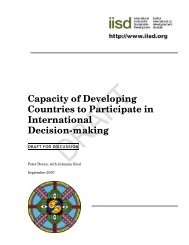Sustainable Public Procurement: Towards a lowâcarbon economy
Sustainable Public Procurement: Towards a lowâcarbon economy
Sustainable Public Procurement: Towards a lowâcarbon economy
You also want an ePaper? Increase the reach of your titles
YUMPU automatically turns print PDFs into web optimized ePapers that Google loves.
55 <strong>Sustainable</strong> <strong>Public</strong> <strong>Procurement</strong>: <strong>Towards</strong> a low carbon <strong>economy</strong><br />
criteria only for those items which are either very expensive or<br />
are energy intensive and are likely to consume large amounts of<br />
energy thereby increasing the company’s overall energy<br />
expenditure. There is a condition in IFFCO’s NIT that if power<br />
consumption is less in one product, then it is the chosen product<br />
for procurement. Power consumption is quantified and then<br />
accordingly, annual total cost is calculated, on the basis of which<br />
a decision is taken. This is a technical requirement and normally<br />
(90%), it is there in procurement of big items only as it is not<br />
feasible to follow this procedure in small requirements due to<br />
cost factor. Similarly, BHEL procures high grade CRGO (Cold<br />
Rolled Grain Oriented Steel) that reduces the heat loss. These<br />
grades are more expensive but are still procured considering their<br />
energy efficiency.<br />
In order to calculate a life cycle cost, the present value of all the<br />
costs is taken into consideration. The costs include initial capital<br />
cost, repair, operation and maintenance cost, cost of energy,<br />
water and replacement over the life time. 35<br />
While calculating the total cost, an inflation factor is added in<br />
each of the cost components to reflect the changes over the time<br />
period considered for the life cycle analysis. The present value of<br />
the costs is calculated by using the discount factor, which is based<br />
on the weighted average cost of capital. The weighted average<br />
cost of capital is the average of the bank interest rates and return<br />
on equity weighted by the proportion of the debt and equity<br />
amount. In the United States of America, in projects related to<br />
energy efficiency, energy conservation projects, renewable energy<br />
projects, the discount factor has a floor of 3% and a ceiling of<br />
12% 36 . It is calculated based on the average yields of the treasury<br />
bonds that could not be called off before 10 years 37 . The discount<br />
factor is dependent on the cost of capital, lifetime considered.<br />
Often the discount factor is adjusted by the inflation rate and a<br />
real discount factor is used in calculating the life cycle costs.<br />
35 A simple formula for life cycle costs would be – Life Cycle Costs =<br />
(Present Value of capital cost, repair, operation and maintenance cost, cost<br />
of energy, water and replacement)<br />
36 Guidance on Life-Cycle Cost Analysis Required by Executive Order<br />
13123<br />
January 8, 2003, www1.eere.energy.gov/femp/pdfs/lcc_guide_rev2.pdf<br />
37 Guidance on Life-Cycle Cost Analysis Required by Executive Order<br />
13123<br />
January 8, 2003, www1.eere.energy.gov/femp/pdfs/lcc_guide_rev2.pdf<br />
T E R I Report No. 2007GL01


